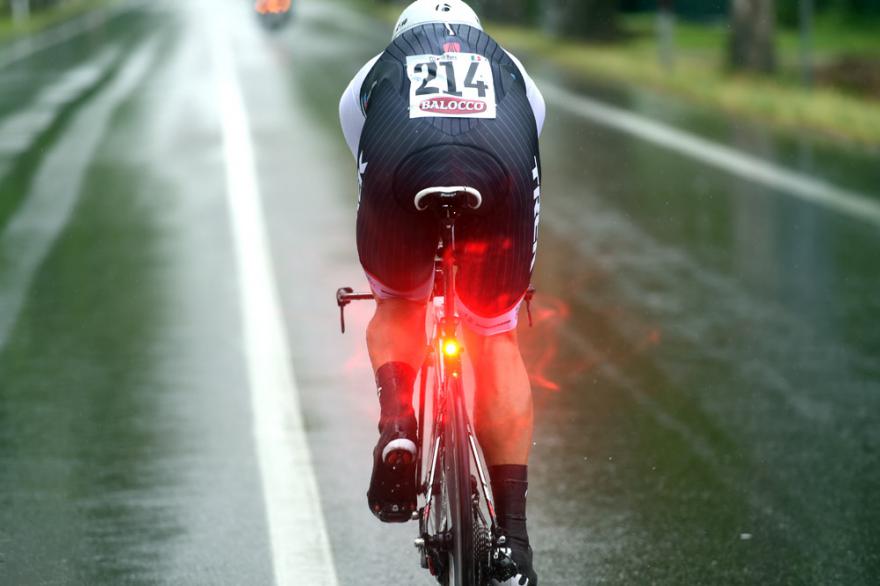Daytime running lights for vehicles are nothing new- motorcycles have had them for decades, they are common on cars, most trains have them, as do airplanes. Yet, despite the fact that bicycles are vehicles, very few road cyclists use daytime front and rear lights. To me, that seems a bit dumb, as adding white and red flashing lights to improve your visibility to self-absorbed drivers may just save you from wearing a bumper.
This may be the only instance where you can actually fix stupid. All it takes is attaching inexpensive lights to your bike.
LEDs have changed the lighting world, from theatrical to architectural to wearable lighting fixtures. Back when I was but a young whippersnapper, my buddy had an LED Star Wars watch, which was the pinnacle of technology at the time. For those of us who survived it, the summer of 1977 was an orgy of product tie-ins to that movie, and we spent every penny we could find between the couch cushions on figurines, lunch boxes, and anything else that had a logo printed on it. In those days, there were no VCRs, no streaming, no pocket-sized devices that held the knowledge of humanity or even downloaded Star Wars movies. Instead, people saw that movie over and over again in theatres, and I remember news articles about people who had seen it over 200 times.
Living in a small town with only 2 movie screens meant I read the Alan Dean Foster novelization over and over, and bought toys from the Sears mail-order catalog. That watch, though, was the coolest thing any of my pals owned. Never mind the fact that you had to pull your shirt over your head and squeeze a button to get the LED numerals to light up, and even then, they were next to impossible to read in anything brighter than the depths of deep space.
A mere 41 years later, and LEDs are now the de-facto lightbulb in our lives. Their high output, long-lived, integrated-into-the-fixture aspect means that when I say to a young child, “how many ski instructors does it take to change a lightbulb?”, that child wonders what the hell a lightbulb is. As a side note, this may offer new opportunities for creating innovative ways to insult ski instructors, and I encourage you, dear reader, to do just that.
With efficacies in LEDs exceeding 150 lumens per watt, looking into one as we did with that watch will result in your retinas being pushed out the back of your skull faster than a Millennium Falcon toy can empty your wallet.
What does this mean for lights on a bike? It means you can have a tiny, lightweight, ultra-bright, long-lasting little gizmo that can announce your presence even in bright sunlight. Many options for lights exist, but I am partial to the Bontrager-branded lights from Trek. In a nearby galaxy, I am considered somewhat knowledgeable in lighting design, lighting controls, and lighting application, and I have used this as an excuse to buy lots and lots of bike lights to play with. Along with the Bontrager lights, I’ve owned lights made by Cycliq, Lezyne, Knog, Nite Rider, Blackburn, Nite-Ize, and many generic lights of varying quality. I’ve settled on the Bontagers as the product line for my lighting needs.
Let’s start with the LED itself with regard to DRLs. There are basically 2 ways for an LED to be used- one for projecting light (as used in roadway lighting, theatrical lighting, interior recessed downlights- those lights that throw light from a distance to a surface) and another for surface luminance (such as are used in brake lights, stoplights, sign lights- those lights that make a surface glow). DRLs are of the second type- they rely on being brighter than the surrounding area or material and increasing contrast between the light and adjacent surfaces. Reflector design in LEDs is everything: without a good design, the image of the light source won’t be big and bright enough to be seen. These lights work to identify the cyclist by creating a bright spot in the driver’s field of vision, something brighter than other things, which draws the eye towards it. The official term for this increased visibility is conspicuity.
Our eyes are hunter’s eyes. They perform best when scanning the horizon and looking for motion. When our ancestors saw this motion, they chased its creator and ate it. In concept, the bright, blinking DRL light is intended to catch the driver’s hunter’s eye and attract focal vision, with the hope that drivers resist the instinct to actually chase you down as a source of delicious calories, or at least, as a hood ornament.
Foveal vision (the center of focus) is a tiny but highly focused part of the entire human visual field, but peripheral vision (the rest) is very sensitive as well. The peripheral vision notices the blinking, then your foveal vision moves to it, analyzes it, and your brain starts thinking of tasty condiments to go along with your prey.
Your fovea is made of cone cells which receive color, while the rest of your retina is made of rod cells (monochromatic response). I can get all nerdy here and talk about photopic and scotopic visual response as well as Purkinje shift, but the upshot is that in the daytime you receive more color data, which diminishes as dusk and eventual darkness set in. If you spend time looking at the night sky, you may realize you can see stars to the sides of your field of view better than those in your focal center much easier. In this instance, your cones are nearly shut down for lack of data, and your rods are in their happy place.
Red rear lights work great in identifying your bike as something a driver will avoid crushing from behind. Similarly, white, flashing front lights work for approaching cyclists. Nothing new here, some motorcycles have a pulsing front light mode, which is designed to catch an observer’s attention. Irregular flashes, such as those used by Trek’s lights, may be more effective due to their lack of pattern. Vision studies have concluded that biomotion (emulated by blinking) seems to catch an observer’s attention more than bright colors alone, which is why adding pedal reflectors, wheel reflectors, reflective fabric on pedaling feet and ankles, and so forth are strongly encouraged.
Impress your friends by using the term ‘biomotion’ in daily conversation. Their confused eyeblinks are a biomotion, albeit a small one that is hard to see from behind a steering wheel.
You want real data? Clemson University has it for you. Go here and read it. It’s fascinating, and if you don’t start hanging lights off your bike and biomotivating after reading it, then I guess stupid is indeed irreparable.
I’ve seen debates on forums where strongly-opinionated sub-bridge-dwellers opine that lights on bikes are ridiculous, that they blind drivers, that drivers are drawn to the light (Don’t go to the light!), that disc brakes will never work on mountain bikes, that clipless pedals will never be more efficient than toeclips and a good Christophe strap, and that bidons should never have been moved off the handlebars. These close-minded clods not only typically fail to contribute to the debate in a useful manner, they also suffer from a high attrition rate as they are removed from the gene pool by drivers who are blinded by their brilliant arguments. Wait long enough, and they are all proven wrong. Like narrow flat bars, thumbshifters, suicide levers, and foam bar ‘tape’, they are bound for the dustbin of history, or at least, the obscure corners of eBay.
It may also be possible that they lack the mental fortitude to scroll through the multiple settings found on high-quality lights, like bright flash, dim flash, steady bright, steady dim, extended middle finger, and so forth. Since it’s bright in the daytime (duh), you should use the bright setting on the light. In low light conditions, use the low setting. Not highly technical, really.
Starting last year, I field-tested lighting conspicuity on road cyclists, mainly by riding with my son and festooning him with enough lights that he looked like a rolling Christmas tree. Between the two of us, we had Trek Ion 100 series lights and Flare RTs, coupled with Flare 350RTs. We were bright, and I noticed that cars on our rural roads consistently gave us a full lane to pass, considerably more than the state-mandated 3 feet. It may have been that they were being good neighbors, or that the pure photonic output from our lights physically pushed them into the adjacent lane. If so, that is friggin’ awesome.
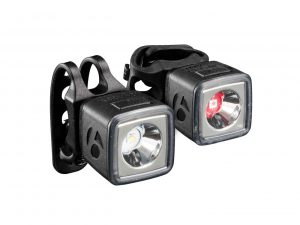
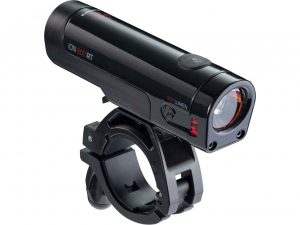
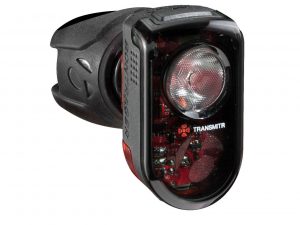
Since I typically sit between my lights, it’s hard for me to get a read on how well they perform out on the road, which is why I brought my kid. He climbs faster than I do (A=F/M, and at 70lbs he is a decidedly low-mass object), so I can see his tail light as he recedes into the distance. Conversely, I descend faster than he does (I have waaaaay more M), so I can see his headlight. If I glance over my shoulder, even if I can’t necessarily see his location exactly, the flashing light is plenty for me to know where he is.
During the 2017 Iron horse Bicycle Classic in Durango, many riders had blinking tail lights on their bikes, which was good to see. I did not notice many with front lights, but we’ll take baby steps here. As my son climbed up Hermosa Hill, weaving through the sea of MAMILs (we had a deal: if he passed 200 people, he got a big Pokemon deck of cards. He stopped counting at 220 egos crushed by his skinny legs). I got my first real-world comparison of the Flare R tail light with whatever everyone else had, and I was very surprised at the high contrast ratios between the Flare and everything else. I was able to track him through the crowd as he climbed, and no other lights were nearly as bright. The irregular flash pattern also stood out. Of course, I have no empirical way to know the type, age, battery level, etc. of every other light that I saw, but after that I went and purchased several more sets of Bontrager lights for my family and friends.
I am also a fan of the RT series variants of the lights, which can sync with a small D-pad controller and ANT+ Sport devices. X20 series Garmin Edge computers that can add apps can control individual lights, and I have set my own 810 to simply turn on every light within range. For city riding, this means that you can use the D-pad to create turn signals, but I use it turn my kid’s lights on and off as we switch between roads and bike paths. I also use it when we ride at night, as I can slowly raise the output from the larger headlamps from low to high as the sun sets and we need more light. I can also use the remote to switch off my helmet-mounted light when I turn to speak to someone so that I don’t destroy their night vision.
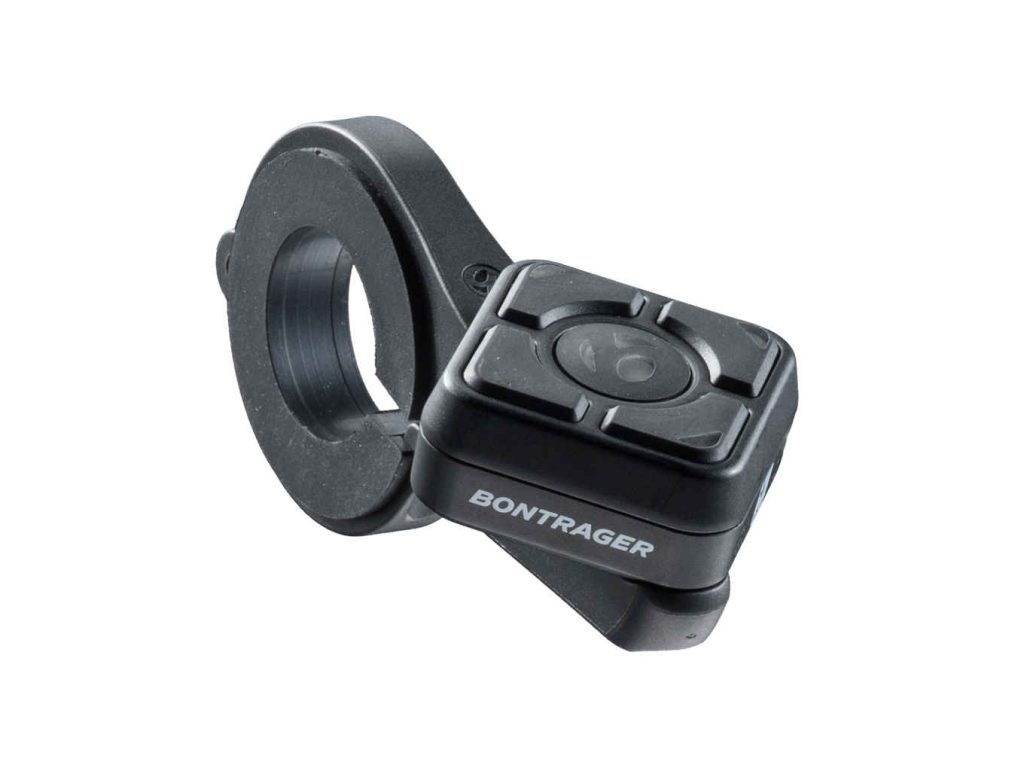
D-pad style controller. You can connect 8 lights to this, which naturally, I have done.
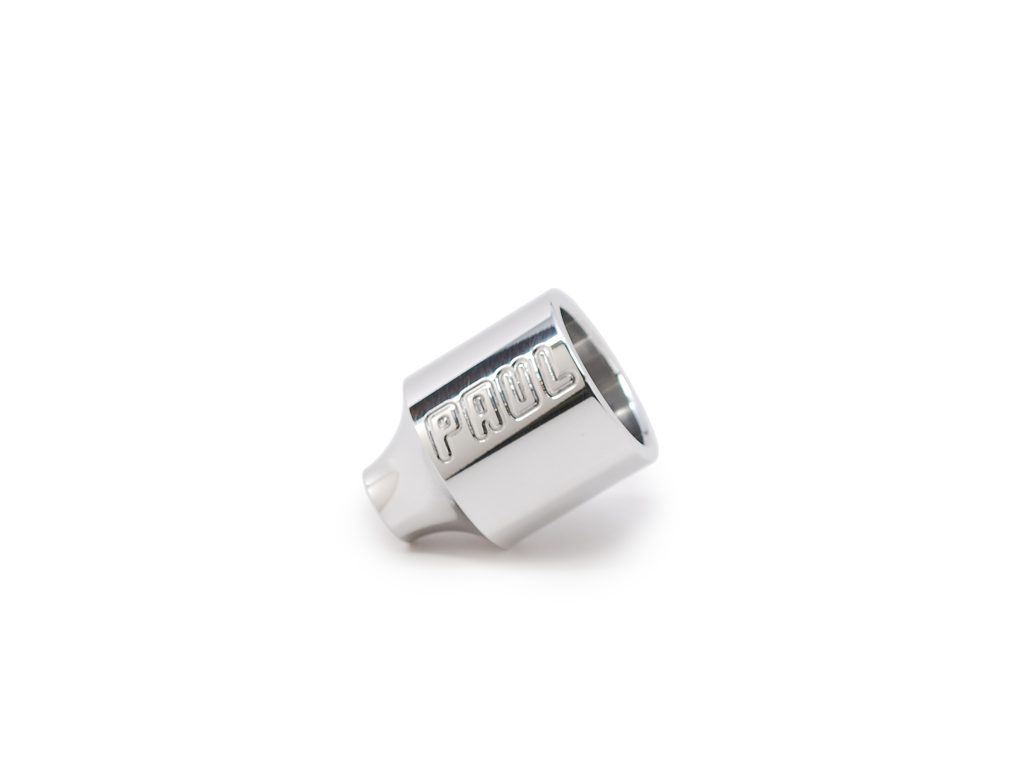
Paul Gino mounts can be attached to rack or fender bosses and then you can put Flares on to use as turn signals.
It has been pointed out that I am enough of a lighting nerd that I put wireless lighting controls on my bike. Until that point, it never occurred to me that this may not be what many people consider to be ‘normal’.
Dash cams are another aspect that has emerged. Several companies have dabbled with ideas for bike-mounted dash cams,but Cycliq is the one that has gotten the most toe-hold. I was an early adopter of these rear-facing light/camera units, purchasing one in the first Kickstarter offering, then another unit because they offered a discount for Kickstarter buyers. I think this is a good idea, and I’m sure that the cameras have provided images that have been used to prove drivers to be at fault in accidents, but it seems that the cameras are mostly used to film kangaroos taking out cyclists.
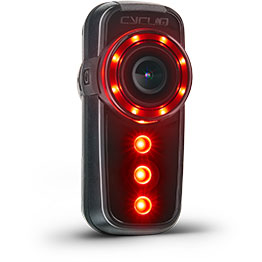
I don’t use the Fly12 cameras on every ride, but I probably should. It seems that when I leave them home, I get a close pass I wish I had filmed. My complaint with the camera/light combo is that the battery life seems sort (maybe 3 hours), and that the LEDs are not super-bright. Granted, my units are the first and second generation, so it may be that the newest versions are the best thing since sliced bread.
Undoubtably you are now convinced that not having lights on your bike will lead to you being flattened like a rodent on the tarmac, we must address the octopus in the room: how to I keep all these charged and ready to go? Between all the USB-powered devices that accumulate in our lives, it’s possible to spend valuable riding hours untangling cables of varying length, gauge, type (USB, little USB, the other little USB, that damn Apple flat thing, etc.). My solution was an Anker 10-port charger stuck in a wooden charging station stand thingy.

Something like this more-or-less holds the lights and charger, with cables bursting out in all directions like an electronic Medusa. I used color-coded heat-shrink tubing to more easily differentiate between the cord types. Most lights these days use micro USB connections, but some devices (ahem, Garmin) use now-antiquated mini USB. And then there’s Apple, who loves to create their own ‘standard’ even more than Shimano does.
So, should you ride with as much conspicuity as you can? Well, yes. It may not save your life, but blinking lights and reflecty clothing can’t hurt. Many manufacturers are working towards higher-conspicuity products, including Trek and Poc (jerseys, jackets, bibs, leg warmers, sleeves, helmets and so on). I love my POC Octal helmet, both because it’s ridiculously comfortable, and because it’s bright orange. In fact, I ride with lots of orange, because I live in Colorado, and I don’t want to be shot when I ride in the woods. There are many versions of DRL-type bike lights available from many manufacturers, so between clothing and lights, you have many options.
Plus, as MAMILs, we are all easily distracted by simple, bright, and shiny objects. Embrace it, ride, and get home for the beer.
